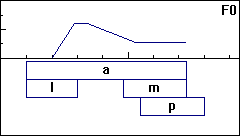Fundamental frequency
Fundamental frequency is dealt with in YorkTalk/IPOX by a rather simplistic model, in which a linear fall is generated for each foot:
foot -->
A = END,
B = f0(100),
f0(100, 190, 240, A-200, A) = (B, 120, 120, 65, 65).
In utterances consisting of more than one foot, each foot overlaps with the coda of the final syllable of the previous foot. Also, phonetic interpretation is left-to-right across syllables. As a result, the variable B in the above rule picks up F0 from the previous foot, creating a smooth, continuous contour.
As phonetic interpretation is primarily top-down, lower-level constituents may refine the basic contour generated at the level of the foot. This is used to implement so-called consonantal perturbations. As an example, consider the following two rules for nasals in coda and the lateral /l/ in onset:
cons:[+coda, NASAL] -->
A = END,
B = f0(-0.48*A),
C = f0(0.88*A),
f0(-0.48*A, 0.16*A, 0.48*A, 0.7*A, 0.78*A, 0.86*A, 0.88*A)
= (B, 0.77*B, 0.72*B, 0.63*B, 0.6*B, 0.6*B, C).
cons:[-coda, LATERAL] -->
A = END,
B = f0(0.275*A),
C = f0(A),
f0(0.275*A, 0.4*A, 0.9*A, A) = (B, 0.875*C, 0.95*C, C).
The effect of these consonantal perturbations is shown below for the input /lamp/. 

